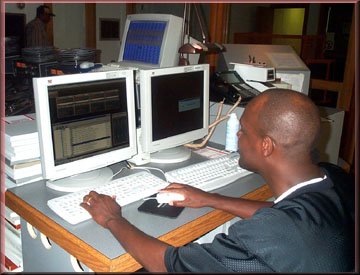![]()

The Dalet System in
the "Bubble"
|
Some of The Strengths of The Dalet Software Dalet5 uses Digigram PCX Boards, equipped with their own microprocessors, for more demanding uses, including recording and multiple-track editing. For less intensive applications and for many workstations with simpler SoundBlaster boards, a computer software solution called Virtual PCX is used. System Audio Specifications Analog I/O, 2 channels, A/D, D/A conversion Digital
input/output in AES/EBU format for PCX9 boards |
The Dalet Digital Audio System Dalet is part of the IDAPS platform or the Integrated Digital Audio Production System. It runs on the Windows Operating System, utilizing a client-server architecture, where several individual computers share a central database linked to a cluster of servers. Dalet comprises a suite of specialized applications, each one corresponding to a specific need of a media outlet: recording, editing, scheduling, broadcasting, database management, etc. Additional resources for you to become more familiar with the IDAPS platform
|